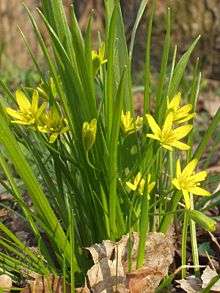Lilieae
The Lilieae are a monophyletic tribe of monocotyledon perennial, herbaceous mainly bulbous flowering plants in the lily family (Liliaceae).
| Lilieae | |
|---|---|
 | |
| Gagea lutea | |
| Scientific classification | |
| Kingdom: | Plantae |
| Clade: | Tracheophytes |
| Clade: | Angiosperms |
| Clade: | Monocots |
| Order: | Liliales |
| Family: | Liliaceae |
| Subfamily: | Lilioideae |
| Tribe: | Lilieae Ritgen |
| Genera | |
|
Sensu stricto | |
Taxonomy
The term has varied over the years but in modern classification constitutes either a broad circumscription (Lilieae sensu lato, s.l.) with eight genera, placed in the subfamily Lilioideae, or narrower circumscription with six genera (Lilieae sensu stricto, s.s.), excluding Tulipa (which now includes Amana) and Erythronium which are treated as a separate tribe, Tulipeae. Within Lilieae s.s., Gagea now includes Lloydia, and Lilium includes Nomocharis, reducing the number of genera to four, with about 260–300 species.[1][2]
| Genera | Sensu stricto | Sensu lato |
|---|---|---|
| Cardiocrinum | Lilieae | Lilieae |
| Notholirion | Lilieae | Lilieae |
| Nomocharis | Lilieae | Lilieae |
| Fritillaria | Lilieae | Lilieae |
| Lilium | Lilieae | Lilieae |
| Gagea | Lilieae | Lilieae |
| Lloydia | Lilieae | Lilieae |
| Amana | Tulipeae | Lilieae |
| Tulipa | Tulipeae | Lilieae |
| Erythronium | Tulipeae | Lilieae |
Phylogeny
The evolutionary and phylogenetic relationships between the genera currently included in Liliaceae are shown in this cladogram.
| Cladogram: Phylogeny and biogeography of the genera of the Liliaceae | ||||||||||||||||||||||||||||||||||||||||||||||||||||||||||||||||||||||||||||||||||||||||||||||||
| ||||||||||||||||||||||||||||||||||||||||||||||||||||||||||||||||||||||||||||||||||||||||||||||||
| Phylogenetic tree reflecting relationships based on molecular phylogenetic evidence.[3][4][5][6][7][1][8][9] *=Liliaceae sensu Tamura; EA=Eurasia NA=North America |
Distribution and habitat
Lilieae s.s. are distributed in temperate Northern Hemisphere areas, with the main centre of diversity in the Qinghai–Tibet Plateau, where about 100 species may be found. Other areas include East Asia, Central and West Asia, the Mediterranean Basin and North America.[2]
See also
References
Bibliography
Books
- Kamenetsky, Rina; Okubo, Hiroshi, eds. (2012). Ornamental Geophytes: From Basic Science to Sustainable Production. CRC Press. ISBN 978-1-4398-4924-8.CS1 maint: ref=harv (link)
- Meerow, A.W. (2012-09-17). Taxonomy and Phylogeny: Liliaceae. pp. 17–55. ISBN 9781439849248. In Kamenetsky & Okubo (2012)
Articles
- Gao, Yun-Dong; Zhou, Song-Dong; He, Xing-Jin; Wan, Juan (January 2012). "Chromosome diversity and evolution in tribe Lilieae (Liliaceae) with emphasis on Chinese species". Journal of Plant Research. 125 (1): 55–69. doi:10.1007/s10265-011-0422-1. ISSN 0918-9440. PMID 21559881.
- Huang, Jiao; Yang, Li-Qin; Yu, Yan; Liu, Yan-Mei; Xie, Deng-Feng; Li, Juan; He, Xing-Jin; Zhou, Song-Dong (2 August 2018). "Molecular phylogenetics and historical biogeography of the tribe Lilieae (Liliaceae): bi-directional dispersal between biodiversity hotspots in Eurasia". Annals of Botany. doi:10.1093/aob/mcy138. PMC 6324749. PMID 30084909.
- Kim, Jung Sung; Hong, Jeong-Ki; Chase, Mark W.; Fay, Michael F.; Kim, Joo-Hwan (May 2013). "Familial relationships of the monocot order Liliales based on a molecular phylogenetic analysis using four plastid loci: matK, rbcL, atpB and atpF-H". Botanical Journal of the Linnean Society. 172 (1): 5–21. doi:10.1111/boj.12039.
- Kim, Jung Sung; Kim, Joo-Hwan; Robinson-Rechavi, Marc (14 June 2013). "Comparative Genome Analysis and Phylogenetic Relationship of Order Liliales Insight from the Complete Plastid Genome Sequences of Two Lilies (Lilium longiflorum and Alstroemeria aurea)". PLoS ONE. 8 (6): e68180. doi:10.1371/journal.pone.0068180. PMC 3688979. PMID 23950788.
- Leitch, I. J.; Beaulieu, JM; Cheung, K; Hanson, L; Lysak, MA; Fay, MF (November 2007). "Punctuated genome size evolution in Liliaceae". Journal of Evolutionary Biology. 20 (6): 2296–308. doi:10.1111/j.1420-9101.2007.01416.x. PMID 17956392.
- Patterson, T. B.; Givnish, T. J. (2002). "Phylogeny, concerted convergence, and phylogenetic niche conservatism in the core Liliales: insights from rbcL and ndhF sequence data" (PDF). Evolution. 56 (2): 233–252. doi:10.1111/j.0014-3820.2002.tb01334.x. PMID 11926492. Archived from the original (PDF) on April 21, 2004. Retrieved 14 January 2014.CS1 maint: ref=harv (link)
- Peruzzi, L.; Leitch, I.J.; Caparelli, K.F. (2009). "Chromosome diversity and evolution in Liliaceae". Annals of Botany. 103 (3): 459–475. doi:10.1093/aob/mcn230. PMC 2707325. PMID 19033282.CS1 maint: ref=harv (link)
- Vinnersten, A.; Bremer, K. (September 2001). "Age and biogeography of major clades in Liliales". American Journal of Botany. 88 (9): 1695–1703. doi:10.2307/3558415. JSTOR 3558415. PMID 21669704.CS1 maint: ref=harv (link)
Websites
- Stevens, P.F. (2017) [2001]. "Liliaceae". AP Web v. 14. Missouri Botanical Garden. Retrieved 10 September 2019.CS1 maint: ref=harv (link) (see also Angiosperm Phylogeny Website)